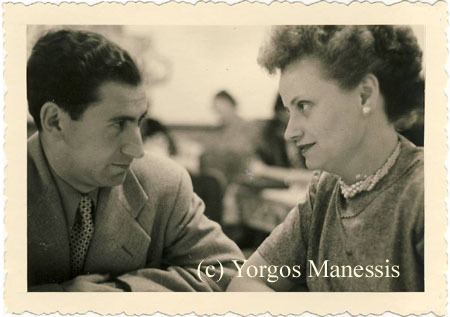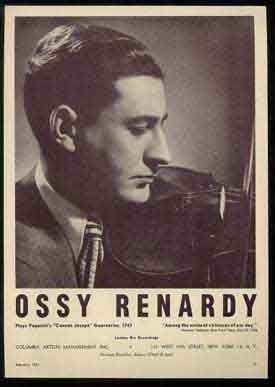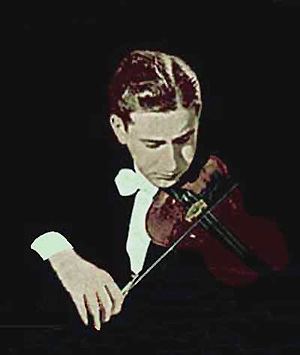Name Ossy Renardy | ||
 | ||
Similar People Charles Munch, Eugene List, Kostia | ||
Brahms violin concerto in d major op 77 ossy renardy
Ossy Renardy (26 April 1920 – 3 December 1953) was an Austrian classical violinist, who made a major impression in Europe before migrating to the United States at age 17. There he made the world premiere integral recording of any version of the 24 Paganini Caprices. He became an American citizen and served in the US Army in World War II, giving almost 500 concerts for the troops. He returned to the concert stage after the war, but only five years into his adult career he was killed in a car crash in New Mexico, at the age of 33. He left a number of recordings.
Contents
- Brahms violin concerto in d major op 77 ossy renardy
- Ossy renardy plays paganini le streghe
- Biography
- Concerto
- Other recordings
- References

Ossy renardy plays paganini le streghe
Biography

Oskar Reiss was born in Vienna in 1920, to non-musical parents who worked as waiters. His violin teacher and possibly his biggest influence was the famous violin pedagogue Thedore Pashkus. He was first seen in public at age 11, and then joined a touring variety troupe for a season in Merano, Italy, beginning on 27 October 1933. On the basis that a name less Germanic-sounding than Oskar Reiss, and one more Italianate-sounding, would be highly desirable, his manager suggested Ossi Renardi. His performance of Schubert's A major Sonata and Paganini's D major concerto at the Merano Casino led to an extended tour of Italy. He returned to Vienna for more preparation, keeping his new name but modifying the spelling to Ossy Renardy. There he played at the Konzerthaus in May 1934, then returned to Italy, where in Milan he played under the baton of Victor de Sabata, who invited him to play with the Vienna Philharmonic. Then came his first tour of the Baltic countries, Norway, Denmark, Sweden, the Netherlands, Austria, France and once again Italy.
Renardy went to the United Kingdom in 1937, in order to escape Nazi oppression. He visited the United States the same year. This came about after the wife of an American concert promoter heard Renardy on Italian radio. His New York debut was at The Town Hall on 8 January 1938, after first touring the mid-west states. His regular accompanist from this time onwards was Walter Robert (born Robert Walter Spitz, 1908, Trieste, d. 1999 Bloomington IN; Robert later had a long artistic association with Josef Gingold).
At his Carnegie Hall debut on 10 October 1939, Ossy Renardy made an extraordinary impression when he played the Lalo Symphonie espagnole, the Concerto in E minor by Nardini, and the Sonatina in G by Dvořák in the first half, and after interval played all 24 solo Caprices by Paganini. He was aged 19 at the time. The following year (1940) he made the world premiere recording of the complete Caprices (albeit in an arrangement for violin and piano by Ferdinand David, the piano part played by Walter Robert; the first recording of the Caprices in their original solo violin form was not till 1947, by Ruggiero Ricci). This was the first of Renardy's many recordings; his last recording, made shortly before his death in 1953, was a second reading of the 24 Caprices. The Guarnerius violin he played was said to have been once owned by Paganini himself, but other sources suggest it was a later copy by Jean-Baptiste Vuillaume. (Renardy's Guarnerius is now owned by an anonymous Australian and is permanently loaned to Richard Tognetti, conductor and principal violinist of the Australian Chamber Orchestra.)
Renardy was already playing for the USO in 1941, and the following year he enlisted in the United States Army, becoming an American citizen in 1943. Throughout the war he appeared in 490 USO concerts for the entertainment of American troops.
In 1947 he returned to the concert stage, and appeared with many of the major orchestras of North America, Europe and Israel. In 1949 he married his sweetheart Suzette Guttwirth, whom he had met in Vienna in 1936.
Ossy Renardy was killed in a road accident on 3 December 1953, aged only 33. His accompanist George Robert (b. 1919 Vienna, d. 2006 Albuquerque NM; no relation to his regular accompanist Walter Robert) was driving him from their last concert at Las Cruces, New Mexico, en route to their next engagement in Monte Vista, Colorado. At Tres Piedras near Santa Fe, their car skidded on an ice slick and, while out of control, was hit by another car coming in the opposite direction. George Robert and the other motorists were not seriously injured, and Renardy's Guarnerius was not damaged.
This was regarded as a great loss to the musical world at the time. Gramophone's obituary of March 1954 said: "At thirty-three he seemed destined to don the mantle of his compatriot Kreisler, whose style of playing was not dissimilar".
Concerto
Ossy Renardy's sole concerto recording with orchestra was the Brahms Concerto in D major, with the Concertgebouw Orchestra of Amsterdam under Charles Munch, made on 27 June 1948. At the time of release, this recording was considered worthy of comparison to those of Heifetz, Szigeti, Neveu and Menuhin. Irving Kolodin reviewed the set in "The New Guide To Recorded Music" (Double Day, New York, 1950), saying "There is no single merit in the Renardy to give it precedence over the Szigeti or Heifetz or Neveu, save a richer serving of the colors in the score than previously provided by any source. However, Renardy's is a very live, youthful, and ingratiating performance, which has its own authentic alertness, consistently controlled. The Munch background is extremely good."
Charles Munch was one of Ossy Renardy's greatest admirers, saying of him, "There is only one word to describe him: perfection. He has everything - style, technique and tone, combined in the most splendid manner".
Other recordings
Walter Robert was Renardy's principal accompanist both in recordings and in concert. Other accompanists he used in recordings included Eugene List and Ernest Lush.
His other recordings include:
